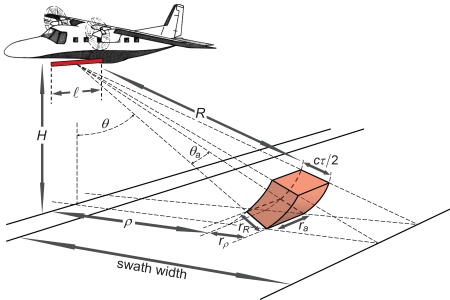Le radar aéroporté à balayage latéral (1/3)(en anglais)
The Side-looking Airborne Radar (1/3)
Principle of operation
The side-looking airborne radar (SLAR) is an active sensor, which emits pulsed radiation in the microwave range and receives the back reflection from a target. Besides a transmitter-receiver, an amplifier and a recorder it has a bar-shaped antenna fastened to the lower side of an aircraft, as seen in the images on page 7 in chapter 2.
The SLAR antenna emits a fan beam, which is horizontally narrow and vertically wide, and pointed sidewise of the flight track. When the short pulse strikes a target, a reflected signal returns to the aircraft. Besides the distance between antenna and target, its intensity depends also on the type of target, especially its roughness and the orientation of its reflecting surface elements. These target properties are characterised by the so-called radar cross-section.

The time-dependent received signal gives the information of the pulse echo in the cross-track direction and is processed to give one radar image line. The processing of the next image line starts when the aircraft has moved a certain distance. Repeating this process produces a two-dimensional image of the radar returns from the ground. The speed of recording is adjusted so that the scales of the image in the along- and cross track direction are nearly equal. As the direct distance (slant range R) from the antenna to a target is determined by a time lapse measurement, the image is distorted somewhat by the difference between the slant range and the horizontal distance or ground range ρ.
The horizontal range of signal returns, which can be used for image construction, is the swath width. It results from the vertical beam angle of the antenna. Signals close to nadir from below the aircraft cannot be used because of the permanently high reflection of pulses from the ground back to the antenna. At long range the signal intensities become low while pixel sizes are large, which sets the upper limit of the swath width.
Radar is almost independent of weather conditions. This is because radar wavelengths in the centimetre range are much larger than water droplets in clouds and rainfall, and therefore radar pulses are not scattered in the atmosphere. Hence, radar is not affected by low optical visibility, which is an advantage when compared with optical instruments. As an active sensor radar can be used in day and night conditions.
Typical characteristics of airborne SLAR are:
- microwave frequency: f = 10 GHz
- microwave wavelength: λ = 3 cm
- radar pulse length: τ = 50 ns
- radar pulse peak power: P = 10 kW
- radar pulse repetition frequency: f = 50 Hz
- antenna length: = 3 m
- antenna horizontal beamwidth angle: θa = 0.5°
- antenna vertical beamwidth angle: 50°
